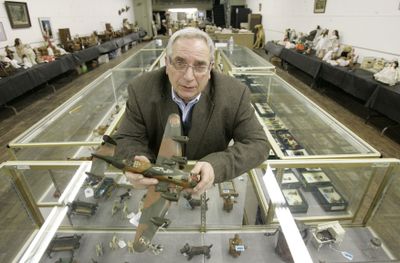Tough market
Sellers of antiques and heirlooms find few buyers

CINCINNATI – People trying to sell their prized possessions these days are finding that – as with homes or stocks – the market value of everything from baseball cards to antique furniture has sunk.
Across the country, collectibles dealers and antiques appraisers are delivering bad news, and feeling pain themselves. The reason is simple: Potential buyers are outnumbered by desperate sellers.
That’s been dashing dreams of an “Antiques Roadshow” moment in which the TV show’s hosts appraise family heirlooms many times higher than the owner expected.
In suburban Chicago, Ron Anderson put his treasured 1985 Bears’ Super Bowl game ball up for sale online through Craigslist.
“Instead of sitting around and worrying about things, I thought I’d do something,” said Anderson, whose construction contracting business is down. Anderson priced the ball, which was autographed by the late Hall of Fame running back Walter Payton and other stars, at $4,500, figuring he’d draw interest from wealthy Bears fans.
He was still waiting for an offer a month later.
From an antiques auction house that caters to wealthy residents of Palm Beach, Fla., to an Ohio pawn shop with a blue-collar clientele, similar stories abound.
Families trying to unload keepsakes for cash are learning that an economy at risk of falling into a deflationary period is taking a heavy toll on the value of these assets, just as it is for traditional investments such as stocks and homes.
Pam Danziger, who studies consumer behavior as president of Unity Marketing, said people who start collections often make a mistake by considering them an investment. And that leads to disappointment when they try to sell them to people who don’t share their emotional ties to the items.
“Even if things are 100 years old, it doesn’t necessarily mean they’re rare or valuable to anyone else,” she said.
While experts generally agree that demand remains high and prices good for very rare and top-of-the-line items, the market for mid-range and lower-quality collectibles is down sharply.
“The majority of items have a value under $10,000, and that’s the material that’s been hit the hardest,” said Mike Gutierrez, a sports memorabilia expert for Heritage Auctions in Dallas.
The online auction company eBay Inc. recently reported its fourth quarter earnings slid 31 percent, although its number of active buyers and sellers grew nearly 4 percent to 86.3 million. Even with more users, gross merchandise volume – the total amount of money that flows from transactions on the site, excluding vehicles – fell 12 percent to $11.5 billion.
At an auction business in downtown Cincinnati that has been around since around the Civil War, owner J. Louis Karp warns clients they face “a terrible market.”
He recently told customers to expect $300 to $400 for a sterling silver flatware set. “They said, ‘Oh my God! It retailed for $1,500!’ ” Karp recounted.
Chris Hill, who owns Kofski Antiques Inc. in Palm Beach, Fla., said he recently sold items for a man badly hurt in the Bernard Madoff investment scandal. Hill, who protects his clients’ confidentiality, said the well-traveled man had an exceptional collection of Oriental art, besides other eye-catching items that sold for about a third of their previously appraised value.
But for collectors who are still financially stable, the recession offers a very good buying opportunity, Hill said.
Steve Wolter, a sports collectibles dealer in suburban Montgomery, Ohio, said the market has its ups and downs. “Things we’ve been trying to get people to sell for years are coming in now. However, the prices that we get for them are also down,” he said.
A man recently brought in baseballs signed by Hall of Famers pitcher Carl Hubbell of the 1920s-’40s New York Giants, shortstop Charlie Gehringer of the 1920s-’40s Detroit Tigers and Negro Leagues star Cool Papa Bell. Wolter barely turned a profit by selling them online for some $290 combined; a couple of years ago he would have expected three times as much.